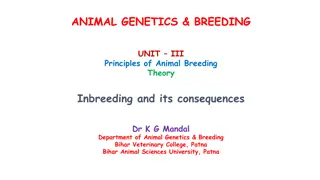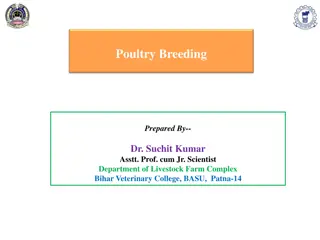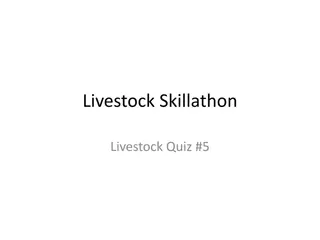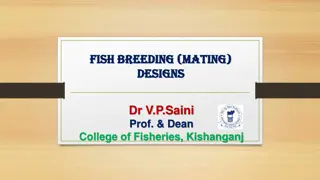Understanding Selection Methods in Livestock Breeding
Livestock breeding involves various methods of selection such as individual selection, pedigree selection, progeny selection, and more. These methods aim to improve desirable traits in animals through controlled breeding programs. Selection criteria include performance, genetic lineage, and specific characteristics. This process helps in creating superior breeds that meet economic and aesthetic preferences of humans.
Download Presentation

Please find below an Image/Link to download the presentation.
The content on the website is provided AS IS for your information and personal use only. It may not be sold, licensed, or shared on other websites without obtaining consent from the author. Download presentation by click this link. If you encounter any issues during the download, it is possible that the publisher has removed the file from their server.
E N D
Presentation Transcript
Selection of Livestock Prepared By-- Dr. Suchit Kumar Asstt. Prof. cum Jr. Scientist Department of Livestock Farm Complex Bihar Veterinary College, BASU, Patna-14
Artificial selection It differs from natural selection in that heritable variations in a species are manipulated by humans through controlled breeding. The breeder attempts to isolate and propagate those genotypes that are responsible for a plant or animal s desired qualities in a suitable environment. These qualities are economically or aesthetically desirable to humans, rather than useful to the organism in its natural environment. Individual selection- It based on breeding value of own phenotypic value of related traits When the improvement through selection is required for more than one traits and individual s performance is the criteria of selection, then three different methods of individual selection applied to estimate breeding value of the individual; Tandem Selection Independent culling selection Selection Index The choosing of breeding stock on the basis of ancestral reproductive ability and quality is known as pedigree selection.
Progeny selection indicates choice of breeding stock on the basis of the performance or testing of their offspring or descendants. Family selection refers to mating of organisms from the same ancestral stock that are not directly related to each other. Pure-line Selection involves selecting and breeding progeny from superior organisms for a number of generations until a pure line of organisms with only the desired characteristics has been established. Mass selection - Animals with superior characteristics (highly heritable breeds) are selected from a herd and then allowed to mate among each other at random. The offspring will show higher performance than their parents. This is because mass selection increases the occurrence of the desirable genes in a population. Progeny testing - It is process of selection based on performance of their average daughter performance.(It is a offspring resulting from selected parents ( Family selection).In this method a group of progenies (offspring) are used as an aid to increase accuracy in the selection of a breeding stock. This is method is used when the character to be selected is of low heritability and expressed by This method takes up to nine years for the results to be seen) one sex only.
Steps in Selection The first step in designing a selection programs is to be decide which characters should be Improved since characters are different in different type of animals eg. dairy animals, meat animals, wool and fur bearing animals egg producing birds/ Poultry Multi Stage Selection The selection involves the identification of the individuals which are superior and it is complex process completed in different stages/ages of the animal and known as multi stage selection. The process of selection starts with the birth of the animal. The new born animals are culled if they have off breed, anatomical and genetical defects. Secondly, the animals are rejected if they have slow growth rate and late maturity.Similarly, the animals belonging to poor pedigree are culled which means the progeny of the parents with low performance are culled
In case of male selection, the young ( dairy sires or rams or bucks or boars or cockerels) are culled based on Poor libido Poor semen quality Poor semen freezability Lastly the animals are selected or culled based on their breeding value for the character in which improvement is required Stages of Selection Physical phenotypic performance and called as the initial selection or phenotyic selection. attributes of The selection at the second stage is based on the breeding value of the animals which is the final selection and called as the genetic selection
Phenotypic Selection or Initial selection Phenotypic selection of the animal based on the followings; The selected animal should be free from any type of genetical or congenital defects The reproductive organs should be normal that is the quantity and quality of semen should meet minimum standard The selected animals should be healthy and free from serious genetic defects or diseases The young animals to be selected should be progeny of better parents and preferably from the progeny of tested ones
Genetic selection or selection based on breeding value The selected animal to be allowed to produce the next generation is based on the breeding value of that animal for the trait in which improvement is sought through selection The selection based on breeding value is called genetic selection The breeding value of an individual can be estimated by on the basis of individual s own performance on the basis of the performance of the relatives of the individual. The relatives of the individual may be its direct relatives ( ancestor and the progeny) or its collateral realtives ( full sibs, half sibs, aunts, niece etc). The breeding value is sum of the Average effect of genes carried by the individual for a trait .
Basis and importance of selection from relative performance a) The use of information from relatives for calculation of breeding value is very important and essential aspect of selection for some character under following conditions Sex limited traits- The traits which are expressed in only one sex The traits which cannot be measured in living animals like slaughter traits, longevity, and lifetime production b) Selection is earlier but traits is expressed in later life c) h2 is low of trait under selection
The breeders decide which individuals shall produce the next generation. The breeder makes a choice. The breeding of animals is based upon the fact that certain qualities are genetic ,hence valuable qualities are passed on from parents to off -springs. The qualities can be maintained or improved in the next generation. The performance of an animal is influenced by two major factors; Genetic potential The environment, which includes: Feeding,Health, care and the ecological conditions. The genetic potential of an animal is inherited from its parents. In selection and breeding animals with superior characteristics are selected and allowed to mate. In the process they transmit the superior characteristics to their offspring. When this is done over a long period of time, it results in livestock improvement.
Most of the economic characters in farm animals that are of concerning to a breeder normally show continuous variation. There is a wide range of variability in these characters which depends on the genetic which make up of the individuals and the environment in which they are grown. For breeding plans, it is necessary to know the relative significant of the heritable and environmental variation of the characters. Breeders use this variability for getting improvement in economic characters through efficient selection strategies. Designing of effective selective breeding programs requires quantitative information concerning nature and scale of genetic and environmental sources of variation and correlation for components of performance. The information on genetic parameters, such as heritability, repeatability, and genetic correlation is a prerequisite for making efficient selection strategies by the geneticists and breeders. In animal breeding, reliable estimates of the genetic variance, environmental variance, and their ratios are important in providing information about the mechanism of inheritance of phenotypically observed characteristics in animals, estimating breeding values, and designing and optimizing breeding programs
Artificial selection is the process by which humans choose individual organisms with certain phenotypic trait values for breeding. If there is additive genetic variance for the selected trait, it will respond to the selection, that is, the trait will evolve. All of our domesticated species, including plants and livestock are the products of artificial selection for desirable traits, such as seeds and fruits that do not disperse readily, increased meat and milk production, and docile behavior. The earliest artificial selection may have been unconscious, but it developed into a sophisticated science of plant and animal breeding; indeed, much of the field of quantitative genetics was developed to improve breeding programs.
Factors To Consider When Selecting A Breeding Stock. Age Level of performance Physical Fitness Health Body Conformation Temperament or Behaviour Quality of products Mothering Ability Adaptability Prolificacy
Level of performance Animals with highest production level selected. Performance best indicated by records. Good performance of animal indicated by; High milk wool and egg production Good mothering ability High prepotency which is the ability of a parent to pass good qualities to their offsprings. The animals with poor performance should be culled. Good records kept and used by the farmer for this purpose.
Physical Fitness Animals selected should be free from any physical defect e.g. mono-eyed, limping, irregular number of teats, scrotal hernia, defective and weak backline Health Sick animals do not breed well and are expensive to keep. Animals that are resistant to diseases pass these characteristics to their off springs
Age Young animals, Those that have not parturated for more than 3-times, should be selected. They have a longer productive life. Old animals are poor breeders and low producers. Production and breeding efficiency decline with age. Body Conformation Animals for breeding to be selected according to proper body conformation. A dairy cow should be wedge-shaped with a large udder, thin legs, long neck. Temperament or Behaviour Animals with bad behaviors should be culled. e.g Cannibalism, egg eating, aggressiveness, kicking Quality of products Select animals that give products of high quality such as meat, wool, eggs, milk.
Mothering Ability Animals selected should have a good mothering ability, That is animals with good natural instinct towards their young ones. This will enable them to rear the young ones up to weaning. Adaptability Animals selected should be well adapted to the prevailing climatic condition in the area e.g Arid and semi arid areas. Prolificacy Animals selected should be highly prolific. That is, animals with the ability to give birth to many offsprings at a time(larger litter). This is a quality that should be considered when selecting pigs and rabbits. The ancestry records assist to choose the prolific breeds for mating
Selection in Goats Consider the following: Fertility. Mothering ability. Growth rate. Twining rate Carcass quality/dressing percentage Growth rate. Suitability to the enterprise - milk or mutton. Health of the animal. Age.
Selection in cattle and Buffalo Consider the following; Level Of Performance Which Include; Milk Yield Butter Content. Length Of Lactation Period. Calving Intervals. Age of the Animal, Fertility, physical Fitness, Health Of The Animal, Body Conformation and suitability of the enterprise-milk or beef
Selection in sheep Consider the following; Level of performance which includes; Mothering ability Growth rate Wool quality Carcass quality Twining rate Age Suitability to the enterprise-wool or mutton Flocking instinct Health of the animal Physical fitness Inheritable defects Fertility Inheritable defects. Fertility.
Selection in Pigs Consider the following: Carcass quality/dressing percentage Suitability to the enterprise (bacon or pork) Growth rate. Health of the animal. Mothering ability. Prolificacy. Number of teats Temperament. Body formation. Age. Heredity defects
Selection in Camels Consider the following: Health of the animal. Age. Temperament. Foraging ability. Fertility. Level of performance-milk, meat, fur and transport.
Major Performance Traits for Beef Cattle All traits of economic value should be considered when selecting beef cattle. The major traits influencing productive efficiency of desirable beef are: Reproductive Performance or Fertility Maternal Ability Growth Rate Feed Efficiency Body Measurements Longevity Carcass Merit Conformation or Structural Soundness
Quantitative genetic analysis is performed on traits showing a continuous range of values, such as height and weight. However, traits displaying a discrete number of values (such as number of offspring) and even binary traits (such as disease presence or absence) are all amenable to quantitative genetic analysis. The genetic architecture of a complex trait consists of all the genetic and environmental factors that affect the trait, along with the magnitude of their individual effects and interaction effects among the factors. The quantitative genetics approach has diverse applications. It is fundamental to an understanding of the variation and co-variation among relatives in natural and managed populations, of the dynamics of evolutionary change, and of the methods for animal improvement and alleviation of complex disease. The roots of quantitative genetics trace back to the work of Galton and Pearson in 1880 1900, who developed many of the basic statistical tools (such as regression and correlation) used in quantitative genetics. Indeed, many of the basic statistical tools now commonly in use were first introduced and developed in the context of quantitative genetics.
A major principle of animal breeding is to select those animals to become parents that will improve the genetic level in the next generation. For quantitative traits that are unable to observe the genotype, it can only measure the phenotypic value, which is influence both by genotype and by environment. Therefore, it needs a way to infer the breeding value from the phenotypic value in such a way to maximize the probability of choosing the correct animals to become parents. The purpose of animal breeding is not to genetically improve individual animals, but to improve animal populations. To improve populations, basic tools are required to identify and utilize genetic differences between animals for the traits of interest. In animal breeding, knowledge of the genetic properties of the traits that are interested in is the first prerequisite in establishing a selection program.
Summary Genetic improvement by selection is a major factor contributing to the profitability of production systems for livestock and poultry. Breeding and selection have resulted in significant economic gains in beef, lamb, wool, milk, pork, egg and chicken production.























